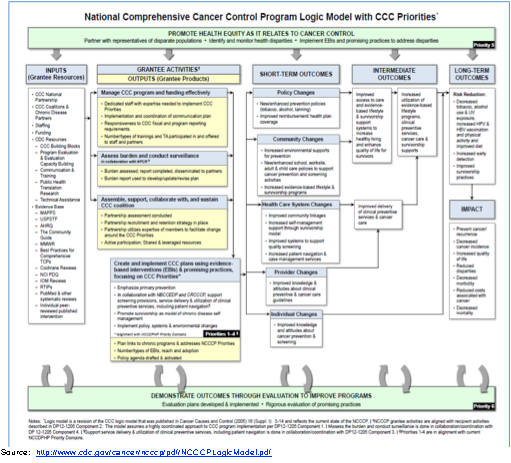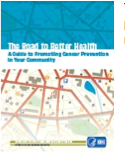Online Course
NRSG 780 - Health Promotion and Population Health
Module 10: Leading Causes of Morbidity and Mortality
Population-based Initiatives to Reduce the Burden of Cancer
National
Since 1998, the CDC has been supporting partnerships across the U.S. to assess the burden of cancer, determine priorities, and develop and implement cancer plans under the National Comprehensive Cancer Control Program (NCCCP). Comprehensive control programs focus on promoting healthy lifestyles and recommended cancer screenings, educate communities about cancer symptoms, increase access to quality cancer care, and enhance survivors’ quality of life.

 The CDC has developed a tool kit for planning and promoting cancer prevention initiatives for the community. Explore this resource to learn more about:
The CDC has developed a tool kit for planning and promoting cancer prevention initiatives for the community. Explore this resource to learn more about:
- Understanding a community’s needs
- Planning a community outreach strategy
- Building community partnerships
- Evaluating efforts
- Resources available

Maryland's overall cancer mortality rate ranks 31th in the nation. Over 31,000 new cases of invasive cancer are diagnosed each year and nearly 11,000 Marylanders die from cancer each year. The most commonly diagnosed cancers are breast, pancreas, lung and bronchus and colon and rectum cancers. Lung cancer is the leading cause of cancer mortality followed by colorectal, breast, pancreatic and prostate. Maryland’s Comprehensive Cancer Control Plan serves as a guide for planning, directing and implementing, evaluating or conducting cancer control research. It identifies 3 goals and objectives to:
- Increase cancer prevention behaviors in priority areas
- Tobacco use and exposure
- Healthy weight, nutrition and physical activity
- Alcohol consumption
- Cancer vaccines
- Ultraviolet radiation exposure
- Radon exposure
- Environmental and occupational exposures
- Reduce the burden of cancer
- Reach new targets for age-adjusted incidence for high burden cancers
- Reach new targets for age-adjusted mortality for high burden cancers
- Achieve screening targets for high burden cancers
- Reduce disparities in cancer incidence and mortality to achieve new targets
- Increase quality of life for cancer survivors
- Reduce days when poor physical or mental health prevent usual activities
- Improve pain management
- Increase written summaries increase by providers of treatments received and check-ups after completing treatment
- Obtain data on survivors who have completed advanced directives and advance care planning
- Access to palliative care services by maintaining Maryland’s “A’ grade on the Center to Advance Palliative Report Card
- Expand data collection of data on hospice utilization
- Improve surveillance of sexual and gender minority populations including health risks
For more information, review the 2021-2025 Cancer Control Plan available at http://phpa.dhmh.maryland.gov/cancer/cancerplan/Documents/
MD%20Cancer%20Program_508C%20with%20cover.pdf
N.B. The plan is also an excellent example for developing goals and objectives and strategies that can be useful for part 2 of your paper.
This website is maintained by the University of Maryland School of Nursing (UMSON) Office of Learning Technologies. The UMSON logo and all other contents of this website are the sole property of UMSON and may not be used for any purpose without prior written consent. Links to other websites do not constitute or imply an endorsement of those sites, their content, or their products and services. Please send comments, corrections, and link improvements to nrsonline@umaryland.edu.